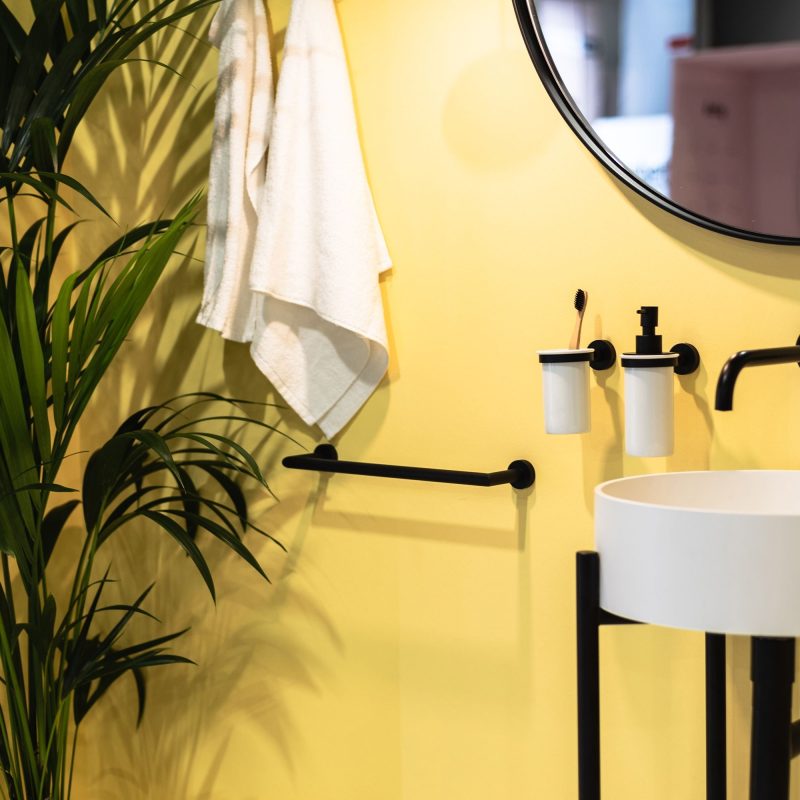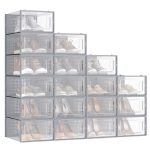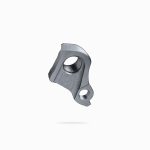Introduction
Installing a towel bar in your bathroom not only serves a practical purpose but can also contribute to the room’s aesthetics and functionality. Determining the appropriate height for a towel bar is essential to ensure ease of use and to maintain a visually pleasing space. While personal preference plays a role, there are standard guidelines that can help you achieve the optimal placement.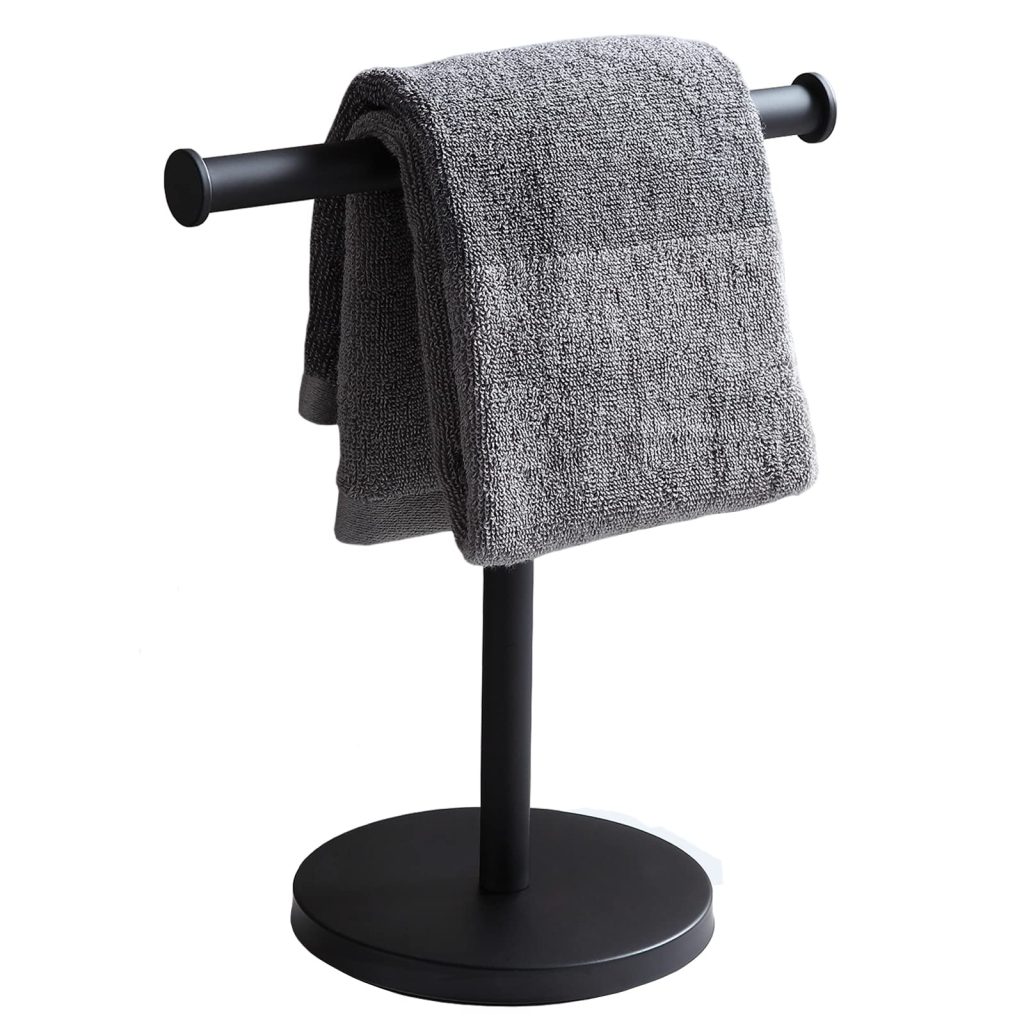
Standard Height for Towel Bars
Traditionally, the standard height for installing a towel bar in a bathroom is approximately 48 inches (122 cm) above the floor. This measurement is taken from the center of the bar to the floor, ensuring that most adults can easily reach the towels without having to bend down or stretch excessively.
Factors to Consider
When deciding on the height, consider the following factors to customize the installation for your specific bathroom and users:
- User Height: If the primary users of the bathroom are children or individuals of shorter stature, lowering the towel bar to around 42 inches (107 cm) may be more convenient.
- Space Constraints: In smaller bathrooms or where there’s limited wall space, you may need to adjust the height to accommodate other fixtures, like mirrors or cabinets, without interfering with their function.
- Towel Size: The length of the towels you intend to hang can influence the bar’s height. Larger bath sheets may require a slightly higher placement to avoid touching the floor.
- Multiple Bars: If you plan to install multiple towel bars, such as one for hand towels and another for bath towels, the hand towel bar is typically installed lower, around 36 inches (91 cm) above the floor, while the bath towel bar follows the standard height.
Installation Tips
- Measure Twice, Drill Once: Before drilling any holes, double-check your measurements to ensure the towel bar will be level and at the desired height.
- Consider Stud Placement: Whenever possible, mount the towel bar into wall studs for maximum stability. If studs aren’t in the desired location, use appropriate anchors designed for the type of wall material to support the weight of wet towels.
- Visual Harmony: Keep in mind the overall design of your bathroom. Try to align the towel bar with other fixtures, like the sink faucet or showerhead, for a balanced look.
- Accessibility: Ensure the towel bar doesn’t obstruct any doorways or paths of travel, maintaining clearances for people with disabilities or mobility aids.
Variations and Alternatives
While the standard height provides a good starting point, alternative arrangements can cater to specific needs or design preferences. For instance, floating shelves with integrated towel bars can offer storage and hanging space without being confined to a traditional height. Similarly, robe hooks or towel rings are versatile alternatives that can be placed at various heights, offering flexibility and convenience.
Factors Influencing Towel Bar Height:
- User Height and Accessibility:
- The height of the towel bar should be convenient for the users of the bathroom. A standard height of 48 inches works well for most adults, allowing them to easily reach the towels without straining. For children’s bathrooms, you might consider installing the towel bar lower, around 36 inches from the floor, to ensure accessibility.
- Proximity to Other Fixtures:
- Consider the location of other bathroom fixtures such as sinks, showers, and toilets. The towel bar should be installed in a place where towels can be easily accessed after washing hands or stepping out of the shower.
- Design and Aesthetics:
- The height of the towel bar can affect the overall aesthetic appeal of the bathroom. It should be installed at a height that visually balances with other elements in the space, such as vanity mirrors and cabinetry. In some bathrooms, designers may choose to install towel bars slightly higher for a more modern look or lower for a traditional or accessible design.
- Type of Towels Used:
- Consider the size and weight of the towels typically used in the bathroom. Larger bath towels may require more clearance below the bar to hang freely without touching the floor.
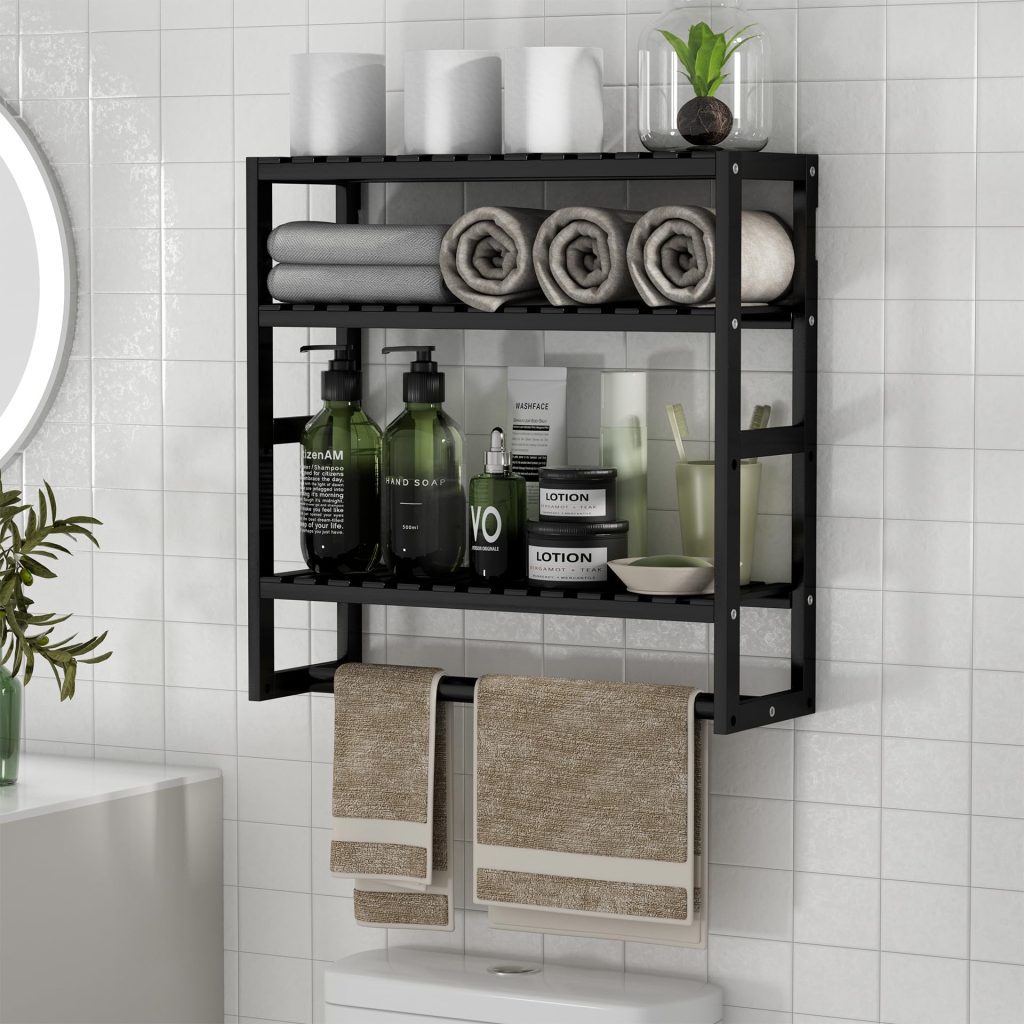 Installation Tips:
Installation Tips:
- Marking the Height: Use a measuring tape to mark the desired height on the wall. Generally, 48 inches from the floor is a good starting point for most situations.
- Wall Studs: Ensure that the towel bar is anchored securely to wall studs or using appropriate wall anchors to support the weight of towels.
- Spacing: If installing multiple towel bars or hooks, ensure they are spaced appropriately to allow towels to hang freely without overlapping.
- Height Adjustment: Customize the height based on the specific needs of the household members. For households with varying heights or mobility considerations, adjust the height accordingly for comfort and accessibility.
Customizing Your Space
In addition to the standard considerations, there are additional ways to personalize and optimize your towel bar installation:
Material and Finish Selection:
The material and finish of your towel bar can significantly impact the bathroom’s visual appeal and durability. Common choices include stainless steel, chrome, brass, and brushed nickel. Consider matching the towel bar’s finish with other hardware in the bathroom, such as faucets and drawer pulls, for a cohesive look.
heated Towel Bars:
For added luxury, consider installing a heated towel bar. These not only warm your towels, providing a spa-like experience, but can also help to reduce humidity in the bathroom by gently drying damp towels. Heated towel bars require electrical installation and should be planned accordingly.
Fold-Down or Swing-Arm Towel Bars:
Space-saving solutions like fold-down or swing-arm towel bars are ideal for compact bathrooms. They can be folded against the wall when not in use, freeing up space and minimizing visual clutter.
Dual-Purpose Installations:
Maximize functionality by incorporating dual-purpose installations. For example, a towel bar that doubles as a grab bar can provide extra support in the shower area. Which is particularly beneficial for elderly or mobility-challenged users.
Maintenance and Longevity:
To ensure your towel bar remains in top condition, follow these maintenance tips:
- Regularly clean the towel bar with a mild detergent and water, avoiding abrasive cleaners that could scratch the surface.
- Dry the bar thoroughly after cleaning to prevent water spots or rust, especially for metal bars.
- Periodically check the mounting hardware to ensure it remains securely fastened to the wall.
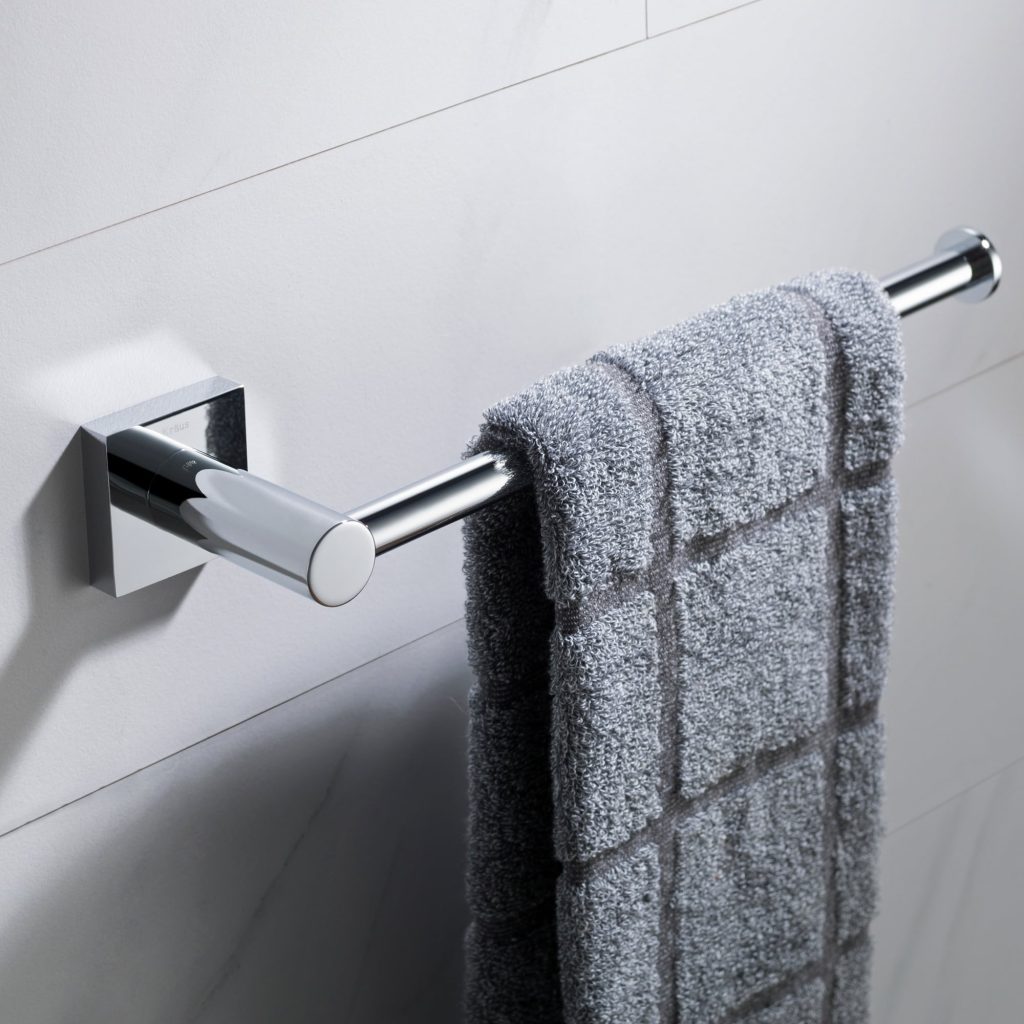
Additional Considerations for Towel Bar Installation:
Family Dynamics and Users:
-
- Children and Elderly: For households with children or elderly individuals, consider adjusting the height of the towel bar to accommodate their needs. Lowering the towel bar to around 36 inches from the floor can make it easier for children to reach and for elderly individuals to access towels comfortably.
Multiple Users:
-
- In bathrooms shared by multiple people of varying heights, it might be beneficial to install multiple towel bars at different heights. This ensures that towels are accessible to everyone in the household without compromise.
Functional Zones:
-
- Adjacent to Shower or Bath: If the towel bar is near a shower or bath, consider installing it at a height that allows for easy access to towels after bathing. This could range from 48 inches for standard accessibility up to 60 inches for a more elevated placement.
Mounting and Structural Considerations:
Ensure that the towel bar is securely mounted to the wall using appropriate hardware. Anchoring into wall studs provides the necessary support for holding the weight of towels. Use a level during installation to ensure the bar is straight and aesthetically pleasing.
Bathroom Layout and Design Harmony:
-
-
- Coordinate the placement of towel bars with other bathroom fixtures such as mirrors, vanities, and shower enclosures. The goal is to create a cohesive and functional layout that enhances the overall usability of the space.
-
Customizing Towel Bar Installations:
- Custom Heights: Depending on personal preferences and specific needs, you can deviate from the standard heights mentioned. Some homeowners prefer higher installations (above 48 inches) for aesthetic reasons or to keep towels further away from potential splashes in wet areas.
Practical Installation Tips:
- Mock Installation: Before drilling any holes, use painter’s tape to mark the proposed location and height of the towel bar. This allows you to visualize its placement and make adjustments as needed.
- Consider Future Changes: If you anticipate changes in household dynamics or bathroom usage over time, installing towel bars at adjustable heights or leaving space for additional bars/hooks can provide flexibility.
- Accessibility Standards: For bathrooms designed to be accessible, follow guidelines that prioritize easy reach and use for individuals with mobility challenges. This might involve lower mounting heights and strategic placement near accessible fixtures.
Conclusion:
The standard height of 48 inches for towel bar installation in bathrooms provides a good balance of accessibility and aesthetics for most users. However, individual preferences, user heights, and bathroom layouts may warrant adjustments. Always consider functionality, ease of use. And visual harmony with other bathroom fixtures when determining the appropriate height for towel bars in your bathroom.
The standard height for installing a towel bar in a bathroom is 48 inches above the floor. Proper planning and consideration of these factors will result in a functional. And aesthetically pleasing installation that enhances your bathroom’s usability and style.
